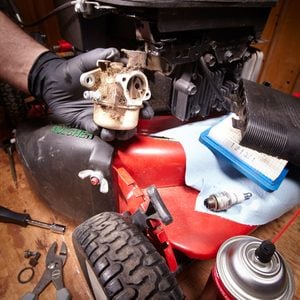Search Results for: broken glass
How to Fertilize a Lawn
Each year, Americans spend billions of dollars on lawn fertilizing to make sure our grass grows green and dense. That includes buying 90 million pounds of fertilizer. “In urban settings, soils are typically lacking the required nutrients for plants and lawns to stay healthy,” says Marc Mayer, Director of Technical Operations at TruGreen. “Soil amendments and fertilizers help to reestablish a nutrient bank in the soil.”
But, we’re probably also overdoing it, says Craig Elworthy, founder of Lawnbright. “Using a large bag of synthetic fertilizer has become a crutch, a shortcut to a great lawn,” he says. “But it’s not sustainable for your lawn or the planet.”
That said, everyone agrees that a little nitrogen can be good for thickening up your lawn and crowding out weeds. Here’s how to find that perfect balance when it comes to lawn fertilizing.
When and How Often Should I Fertilize My Lawn?
It depends on where you live and the type of grass and fertilizer you’re using. For many, that means starting in the spring. “In the spring, apply just enough fertilizer to help green up your lawn,” says Churchill. “About half the normal amount will do.”
If you have a cool-season lawn like Kentucky bluegrass, perennial ryegrass or tall fescue, fall is another key time to apply nutrients. This will help replenish food reserves after a year of growing and before winter sets in. For warm-season lawns, like bermudagrass and centipede grass, you’ll want to fertilize during the summer and apply potassium in the fall to help the turf through the winter, says Mayer.
Elworthy, who lives in Massachusetts, applies a slow-release organic liquid fertilizer every eight weeks, starting in late April. He also mulches his clippings, which cycles nutrients back into the soil.
“Since I mulch the clippings, I only need to use a small amount of actual fertilizer a few times during the growing season,” he says. “Healthy soil, mowing and watering are much more important for a healthy lawn, so if you can get those cultural practices right, you hardly need much fertilizer at all.”
When To Call a Pro
It can save some hassle to consult a pro at least once, to learn a good regimen for your particular situation. “Lawn care is rarely, if ever, one-size-fits-all, and the same goes for fertilization timing,” says Mayer. “Homeowners can tap a lawn care professional to plan a proper fertilization regimen that’s tailored for their lawn.”
Other reasons to call a pro include:
- Unexpected weather, like flooding, drought and freezing
- If you need heavy machinery, like aerators
- If you have a very large lawn, or a large renovation planned
- If you travel a lot or are otherwise short on time
How to Tune Up A Lawn Mower in a Few Easy Steps
The first engine I took apart and rebuilt was a 2-cycle Briggs and Stratton from a lawn mower I found in the trash. That was over 60 years ago, and I’ve been rebuilding internal combustion engines (ICE) ever since. Every ICE engine—especially if it’s a small engine— needs regular maintenance to keep performing at its very best. That includes your lawn mower.
“Nothing will ruin your day quicker than pulling the starter cord on your lawn mower until it feels like your arm is going numb, and not having the lawn mower start,” says David Bodzioch, an ASE and Pennsylvania Department of Education certified Recreational Power Equipment Technology and Automotive Technology instructor.
When to Tune Up a Lawn Mower
Late winter is the best time to tune up a lawn mower. Don’t wait until your grass is six inches tall before rolling out your lawn mower, hoping it starts. Bodzioch said, replacement parts are plentiful, it’s the perfect DIY job, and if you need to take it to a repair shop, it’s usually their slow season.
Safety
Ensure your lawn mower is cool and unplug the spark wire or cable from the spark plug. Wear safety glasses and heavy work gloves when working near or around the mower cutting blade. If the fuel tank has gasoline in it, have a fire extinguisher nearby.
PRO TIP: Before you begin, empty the gas tank, or seal the gas tank by removing the gas cap and covering the opening with a plastic bag. Screw the cap back on over the plastic bag. This will help prevent gas spilling when it comes time to tilt the mower to change the oil.









